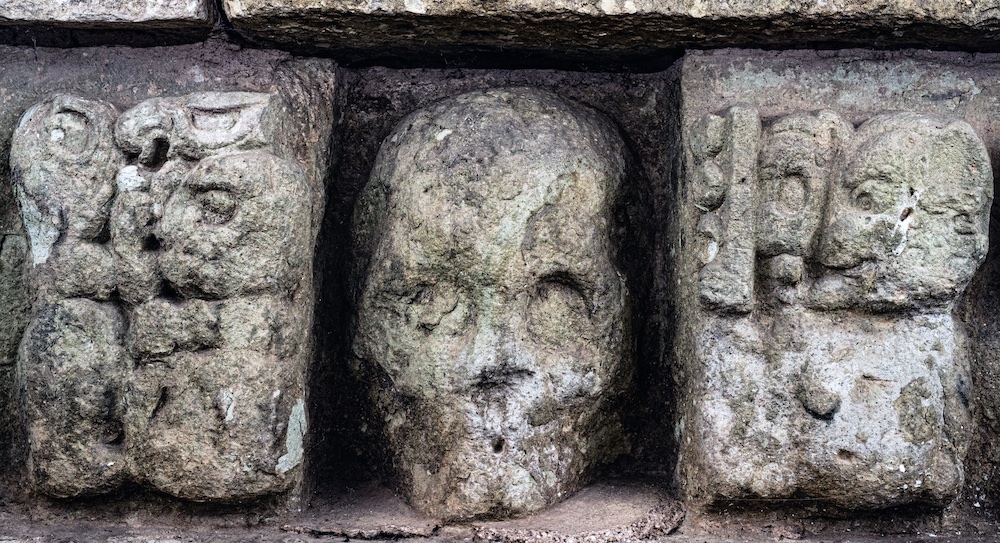The Skull Rack of Copan is rarely compared with the tzompantli of Chichen Itza or Tenochitlan
Most skull racks have the skulls held in place with sticks. The two most infamous tzompantli are of Chichen Itza (Maya/Toltecs) and Tenochitlan of the Aztecs. But I would like to suggest adding the monumental Copan sculpture of the stairway of Structure 16 that shows horizontal rolls of frontal skulls. No sticks are visible piercing each skull but they are in a row. What is different is the variant of a goggle-eyed Tlaloc in the center (are these skulls offerings to a Copan-ized version of Tlaloc?). But what is important is that we have dedicated time and effort to photograph these frontal skulls with good lighting. We will have a complete FLAAR Reports on this sculpture but the present web page will introduce the rows of skulls.
There are also frontal bas-relief skulls at the end of stone sculptures near Altar O.
In the row of hieroglyphs below the doorway into Temple 22 is another skull
Several altars have a frontal skull at their end, but only Altar B’ (Bprime) is visible
There are drawings that show several altars have a frontal skull at each end (a smiley face skull). But we found only one, Altar B’ (Bprime) in-situ (near Altar O); none are in the Copan Sculpture Museum.
Suggested Reading on Skull Racks (and Crossed Bones) including Copan
- 1999
- The Skull Rack in Mesoamerica. Chapter 15 in Mesoamerican Architecture
as a Cultural Symbol, Edited by Jeff Karl Kowalski. Oxford University Press.
Easy Download: https://www.academia.edu/1298934/The_skull_rack_in_Mesoamerica
Yes, Virginial Miller does mention and discuss skulls and crossed bones at Copan. But there is not one single photograph of the skull rack of Copan in the Miller article. However she also mentions human long bones (but again, not showing any photo or drawing) (1999: 349):
At Copan, a small three-room vaulted annex (Structure 10L-230) to the temple of the Hieroglyphic Stairway pyramid (Structure 10L-26) was once decorated with reliefs of fleshless human long bones and skulls. While no bodies were found, a broken eccentric flint on the floor of the central chamber hints at a possible sacrificial function (Fash 1991: 149). Dated to the mid-eighth century, this structure may be the earliest in Mesoamerica to display the skull-and-bone motif that becomes so prominent in the Postclassic. Echoing the war and death themes of both Structure 10L-26 and 10L-230, the later Structure 10L-16's facade was decorated with tenoned stone skulls (Fash 1991: 169).
- 1991
- Scribes, Warriors and Kings: The City of Copan and the Ancient Maya. Thames & Hudson. 192 pages.
Skulls and bones mentioned twice but not one single photograph or drawing of either.
- 2001
- Scribes, Warriors and Kings: The City of Copan and the Ancient Maya. Thames & Hudson. 192 pages.
First posted February 20, 2024 by Nicholas Hellmuth


































